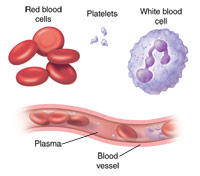What Is Plasma?
Plasma is the often-forgotten part of blood. White blood cells, red blood cells, and
platelets are important to body function. But plasma also plays a key role. This fluid
carries the blood components throughout the body.

Facts about plasma
Plasma is the largest part of your blood. It makes up more than half (about 55%) of
its overall content. When separated from the rest of the blood, plasma is a light
yellow liquid. Plasma carries water, salts, and enzymes.
The main role of plasma is to take nutrients, hormones, and proteins to the parts
of the body that need it. Cells also put their waste products into the plasma. The
plasma then helps remove this waste from the body. Blood plasma also carries all parts
of the blood through your circulatory system.
How does plasma keep you healthy?
Plasma is a critical part of the treatment for many serious health problems. This
is why there are blood drives asking people to donate blood plasma.
Along with water, salt, and enzymes, plasma also contains important components. These
include antibodies, clotting factors, and the proteins albumin and fibrinogen. When
you donate blood, healthcare providers can separate these vital parts from your plasma.
These parts can then be concentrated into various products. These products are then
used as treatments that can help save the lives of people suffering from burns, shock,
trauma, and other medical emergencies.
The proteins and antibodies in plasma are also used in therapies for rare chronic
conditions. These include autoimmune disorders and hemophilia. People with these conditions
can live long and productive lives because of the treatments. In fact, some health
organizations call plasma "the gift of life."
Donating plasma
If you want to donate plasma to help others in need, you will go through a screening
process. This is to make sure your blood is healthy and safe. If you qualify as a
plasma donor, you'll spend about an hour and a half at a clinic on every follow-up
visit.
During the actual blood donation process, your blood is drawn through a needle placed
in a vein in one arm. A special machine separates the plasma and often the platelets
from your blood sample. This process is called plasmapheresis. The remaining red blood
cells and other blood components are then returned to your body, along with a little
saline (salt) solution.
Type AB plasma can be given to people of all blood types. Because type AB blood is
rare in the U.S., this plasma is usually in short supply.
At noncommercial donation sites, people can donate plasma every 28 days, up to 13
times a year. To learn more about donating blood, visit the American Red Cross at https://www.redcrossblood.org